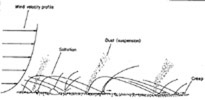
|
Are They Telltale Ripples?
- Click the image above for a larger view
- Full-Res JPEG (1024 x 1024) (215.0 kB)
- Full-Res TIFF (1024 x 1024) (2.6 MB)
Caption:
This false-color image from the Mars Exploration Rover Spirit's panoramic camera shows peak-like formations on the martian terrain at Gusev Crater. Scientists have been analyzing these formations, which have coarse particles accumulating on their tops, or crests. This characteristic classifies them as ripples instead of dunes, which have a more uniform distribution of particle sizes. Scientists are looking further into such formations, which can give insight to the wind direction and velocity on Mars, as well as the material that is being moved by the wind. This image was taken on the 40th martian day, or sol, of Spirit's mission.

Click on image for larger view
[Image credit: NASA/JPL/ASU]
This diagram illustrates how windblown sediments travel. There are three basic types of particles that undergo different motions depending on their size. These particles are dust, sand and coarse sand, and their sizes approximate flour, sugar, and ball bearings, respectively. Sand particles move along the "saltation" path, hitting the surface downwind. When the sand hits the surface, it sends dust into the atmosphere and gives coarse sand a little shove. Mars Exploration Rover scientists are studying the distribution of material on the surface of Mars to better understand how winds shaped the landscape.
Cataloging Keywords:
| Name | Value | Additional Values |
|---|---|---|
| Target | Mars | |
| System | ||
| Target Type | Planet | |
| Mission | Mars Exploration Rover (MER) | |
| Instrument Host | Spirit (MER-A) | |
| Host Type | Rover | |
| Instrument | Panoramic Camera (Pancam) | |
| Detector | ||
| Extra Keywords | Atmosphere, Color, Crater, Dune, Dust | |
| Acquisition Date | ||
| Release Date | 2004-02-26 | |
| Date in Caption | ||
| Image Credit | NASA/JPL/Cornell | |
| Source | photojournal.jpl.nasa.gov/catalog/PIA05453 | |
| Identifier | PIA05453 | |
